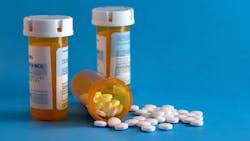“Progress is slowing”: The pandemic’s effect on dental opioid prescribing rates
Even as dental professionals are less likely to prescribe opioids to patients for dental pain than before several years ago, the COVID-19 pandemic seems to have slowed efforts to reduce opioid prescribing in dentistry—results of a new study that researchers say provides reasons for both “optimism and concern.”
Findings published in PLOS ONE that researchers from the University of Michigan Medical School and School of Dentistry say is the most recent data on dental opioid prescribing in the US, and the first to study changes in pandemic-related prescribing, indicated a 45% decrease in opioids prescribed for dental procedures from 2016 to the end of 2022. But, according to the study, the rate of decline in prescribing slowed significantly during the pandemic years, starting in early 2020.
According to the study, data shows that the rate of US dental opioid prescribing increased until 2016 and subsequently decreased through 2019, “potentially owing to dental opioid stewardship initiatives and heightened societal awareness regarding the harms of opioids.”
A lapse in data from 2019 until 2022 was deemed an important one by researchers in that such information was needed to shed light on how opioid prescribing trends were affected by the pandemic. For example, notes the study, the initial decrease in dental procedures at the outset of the pandemic in March 2020 ostensibly would have led to a decrease in opioid prescriptions. On the other hand, dentists may actually have been more likely to prescribe them due to issues with scheduling routine care for pain, as well as a “stopgap” measure where appropriate care for dental emergencies was hindered by the pandemic.
Changes in prescribing trends from 2016 to the present
As such, researchers analyzed changes in trends in monthly prescription rates between two periods, January 2016 to February 2020 and June 2020 to December 2022, ultimately recording a decrease of almost 45% in the number of dental opioid prescriptions from 2016 to 2022.
But the rate of decrease was not shown to be even within those periods. After years of a consistent monthly rate of decline, from January 2016 to February 2020, the decline rate slowed significantly from June 2020 to December 2022, during which time some 25 million dental opioid prescriptions were dispensed. But if the trends from the earlier studied period had held, the study says, “this number would have been 18.9 million. Consequently, 6.1 million more dental opioid prescriptions were dispensed during June 2020-December 2022 than was expected, representing a 32.0% increase.”
“These data suggest the dental profession has made major strides in reducing opioid prescribing, but also suggest that progress is slowing,” said Kao-Ping Chua, MD, PhD, senior author of the new study and assistant professor of pediatrics at the University of Michigan.
“A natural plateau”?
In keeping with overall industry efforts and guidelines toward increasing stewardship and limiting dental opioid prescribing, findings do indicate “large reductions in dental opioid prescribing were achieved between 2016 and 2022.” On the other hand, the study notes, the halt in progress in reducing such prescribing during the pandemic highlights “the importance of continuing to invest in efforts to monitor and improve the appropriateness of dental opioid prescribing.”
The study noted that a final potential explanation for the change in the prescribing rate is that prescribing opioids for dental pain “is reaching a natural plateau and that any further reductions in prescribing would be infeasible without worsening pain control.” However, it goes on to say that this possibility seems unlikely, “given that the majority of dental opioid prescribing is for routine procedures for which nonopioid analgesics are safer and equally effective.”
About the Author
Elizabeth S. Leaver
Digital content manager
Elizabeth S. Leaver was the digital content manager for Endeavor Business Media's dental group from 2021-2024. She has a degree in journalism from Northeastern University in Boston and many years of experience working in niche industries specializing in creating content, editing, content marketing, and publishing digital and magazine content. She lives in the Boston area.
